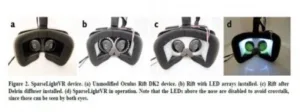A recently published article from the Proceedings of the 2016 CHI Conference on Human Factors in Computing Systems, “Augmenting the Field-of-View of Head-Mounted Displays with Sparse Peripheral Displays” by Robert Xiao, Carnegie Mellon University and Microsoft Research and Hrvoje Banko, Microsoft Research presents some new ideas to make the VR experience less nauseating for users.
Based on existing research, one of the key issues with VR and AR headsets is the potential to induce nausea in the user, referred to as simulator sickness. The general reason for this kind of sickness is the mismatch between visual cues and other sensory input that causes a conflict in processing all sensory input. They refer to ‘vection’ as a perception of self-motion while using a headset. This vection is of course in conflict with other sensors like the inner ear that senses acceleration, for example.

In the current implementation, AR and VR headsets are still limited in their field of vision to a much smaller value than our human vision system is capable of acquiring. Recent research has shown that devices with larger field of view do not necessarily reduce the nauseating effect, but as a matter of fact may even increase it. The authors suggest that a high resolution display in the peripheral part of our vision system increases the potential mismatch of vision perceived motion, which is of course in conflict with the real motion of the person.
The group created headset prototypes they call SparseLight AR and SparseLight VR in which they included a set of discrete LEDs that can be individually driven to any color and brightness. Since the LEDs are discrete and rather large (5mm by 5mm) they covered them with a diffuser to avoid the creation of bright spots in peripheral area.
Since they were using computer generated content they matched the LEDs to the part of the scenes that were not visible in the main display. They assigned color and brightness values to each LED to create a very low resolution image of the scene in the peripheral area. In a second step they creates optical motion cues that were countering the motion cues of the main display. If the main display provides cues for a forward motion, the peripheral vision provides cues for the opposite motion and thus decreasing any vection that the user may experience. They call this the “countervection” mode.
They performed some testing with these devices showing that this concept was seen as an improvement over the regular AR / VR devices. With 17 participants, 14 completed all the testing and 11 rated the “countervection” mode as reducing nausea. – NH

